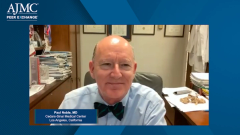
Who is Diagnosing and Treating ILD?
Daniel Culver, DO, and Paul Noble, MD, highlight the types of physicians who manage patients with different forms of ILD, from diagnosis to treatment, as well as the process of referrals.
Episodes in this series

Ryan Haumschild, PharmD, MS, MBA: Dr Culver, I want to call on you to weigh in. Who’s typically treating and diagnosing these patients, and who are you getting that referral from?
Daniel Culver, DO: As far as how patients are coming in, it’s as you would predict. Patients come from various sources: primary care doctors, incidental findings in the emergency department, and referrals from rheumatologists aren’t uncommon. We know that patients wait too long. For IPF [idiopathic pulmonary fibrosis], it takes about a year on average. More than half the patients take about a year to come in after the onset of symptoms. There are delays at every step of the process. The patient deciding they’re going to take medical care takes some time. The patient getting into their internist and being evaluated takes on average about 3 visits for IPF. Getting referred to a lung doctor is a delay. If the lung doctor finally gets ahold of the patient, generally it goes a little faster. But there’s this Sherlock Holmes thing that Kristin [Highland] was talking about that also takes some time. By the time they get to us, we want to accelerate the process. Having the chance to get the appropriate testing done without a lot of negotiations with payers is always well appreciated by the patient and us.
It’s been shown that earlier diagnosis associates with better outcomes, so getting the patient into a center and looking at things relatively earlier makes a lot of sense. I want to highlight something else Kristin said because it’s underrecognized: hearing crackles on lung exam, at least for IPF, is just as sensitive as almost anything else we do. A good physical exam cannot substitute for asynchronous telemedicine. Having a doctor listen to the patient’s lungs is very important for screening for these diseases.
Ryan Haumschild, PharmD, MS, MBA: That’s a great highlight, especially as telemedicine has taken off. It applies to many areas, but we’ve got to make sure that a quality physical exam—especially with these patient populations—stands out. I’d like for you to speak on a few more things because you brought up some great points that I want to roll into it. Referrals are important. It has to come to a specialist for disease to be picked up earlier. I’ll talk about this a little later, but you’re right: early recognition leads to better outcomes overall and better-controlled disease. Do you see that with treatment? When you decide to move forward with some type of medication treatment, do payers require that it’s a pulmonologist or a lung doctor, the 1 prescribing that as prior authorization? Or do you see rheumatologists trying to manage these patients if someone is coinfected? I’m curious if you could speak to that.
Daniel Culver, DO: In our experience, we have a very collaborative center and we work closely with other specialists. I’ll be curious to hear about what it is in Los Angeles, but in general, the rheumatologist would like a pulmonologist helping them and vice versa for complex rheumatologic issues. We want to work as a team. The amount of knowledge that happens in medicine is doubling a little less than every 2 months. For any 1 specialty to understand enough about a complicated patient is becoming less and less likely. Team-based medicine is where we need to be and where we’re going to increasingly go in the future. It’s the lung doctors who really understand how to interpret the physiology, how to integrate pathology, radiology, serology, and history to make a story that’s cogent. I still think the lung doctors have a central place in managing any of these interstitial lung diseases [ILDs]. I’d be very reluctant to endorse any other specialties having the experience to do it, frankly.
Ryan Haumschild, PharmD, MS, MBA: Dr Culver, would you comment any thoughts around how the management occurs over at your center, especially when some of these patients might be first recognized by rheumatologists. Do you see them managing these patients, prescribing treatment for them, or is it usually a referral into your team?
Daniel Culver, DO: It’s a team-based approach. There are medications that each specialty is more comfortable with and more familiar with. There needs to be a bit of a seamless integration between approaches. There are plenty of patients with connective tissue–related interstitial lung disease that all of us will treat when there’s not extrapulmonary rheumatologic manifestations dominating the picture. That doesn’t mean we don’t talk to a rheumatologist or have the patient look at a rheumatologist. It’s a question of who’s driving the bus or who’s the quarterback in the situation. In general, for drugs like antifibrotics or drugs like pulmonary hypertension drugs, a pulmonologist should be organizing that. For the immunomodulatory agents, there’s a little more diversity in the practices, and that’s OK.
Ryan Haumschild, PharmD, MS, MBA: That’s great. That’s what I was curious about, seeing the differences between those medications. Last question, and I can probably transition this 1 to Dr Noble. As we do a diagnosis, if we’re focusing on idiopathic vs progressive vs sclerotic ILD, what does the diagnosis process look like between those 3 specific areas within ILD?
Paul Noble, MD: I’d like to very briefly add 1 thing to what Dan was saying about the rheumatologist. One fascinating thing is that the lung is not another joint, and the drugs that work great for the Enbrel [etanercept] of the world, which is great for arthritis, don’t do anything for the interstitial lung disease, and the antifibrotics don’t do anything for the associated connective tissue disease. I feel strongly that a rheumatologist shouldn’t be managing the lung disease because it doesn’t behave as part of the overall disease process.
In terms of looking at how we sort these out, making those diagnoses, it requires some keen investigation. History physicals are extremely important. Patients frequently won’t be aware of some of their exposures, so you really have to ask them about it. Many times I’ll make the joke with chronic HP [hypersensitivity pneumonitis] and parakeets—they know that bird is causing the lung disease, but they’d rather get rid of the spouse than get rid of the bird. You have to get into their heads a little about that, so history is really important. Then for the connective tissue diseases, these are hard to diagnose. I’m sure that Kristin and Dan have their favorite profile patterns. I have my own that I like to use and try to identify whether there could be an early onset for a connective tissue disease. It seems to me that, over the last 5 years, I’m finding more reasons for there to be fibrotic lung disease and come down less with what I’m 100% convinced is idiopathic pulmonary fibrosis.
The big evolution, and Dr Culver alluded to this, is that we don’t do nearly the number of video-assisted thoracoscopic lung biopsies. We don’t do cryobiopsies at Cedars-Sinai, but I used to biopsy everybody. I’ve always looked at every past slide of any patient I’ve ever cared for, but I can count on 1 hand in the last year when I’ve sent somebody for a surgical lung biopsy. The imaging has evolved so tremendously that I rarely think I’m going to learn something new. There are exceptions, of course, particularly in younger people I send for a surgical lung biopsy. Then the physiology is really important. I also like the 6-minute-walk test. If somebody doesn’t desaturate with fibrotic lung disease, it’s unlikely that they have IPF. It could be, but it drops it much less likely.
As Kristin alluded to, IPF is largely a disease of old men. It’s Mother Nature’s goal to get rid of us because we’re pretty worthless. If you’re a woman, the pretest probability of this being an underlying connected tissue disease is enormously high, so you double down in terms of doing your connected tissue disease serologies. If I’m not convinced they have something that’s going to progress, bring them back in 3, 6 months. Sometimes I’ll repeat the serologies, and lo and behold that CCP [cyclic citrullinated peptide] is over 100 U/mL or something like that, whereas it wasn’t before. It really is a continuum in terms of establishing that diagnosis.
Ryan Haumschild, PharmD, MS, MBA: You had some great 1-liners there. From managing the lungs to the joint, I appreciate that background. You explained it well, and also that it’s still a difficult area for diagnosis even for the experts. That’s why we rely so much on pulmonologists to have good management of these patients but communication with our partners.
This transcript has been edited for clarity.
Newsletter
Stay ahead of policy, cost, and value—subscribe to AJMC for expert insights at the intersection of clinical care and health economics.









































